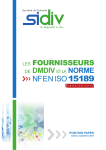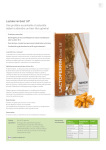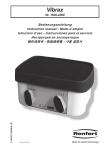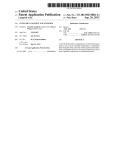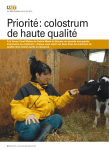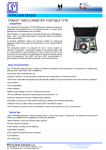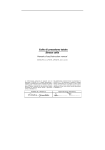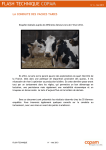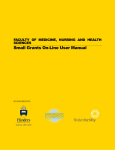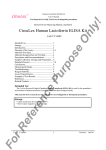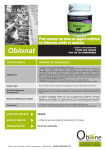Download Mode d`emploi ELISA Lactoferrine Bovine
Transcript
SC32_PR_v1_14/09/2015 ELISA bLF kit Kit ELISA pour la quantification de la lactoferrine bovine dans les laits et poudres de lait, les colostrums et poudres de colostrum et les sérums bovins ELISA kit for quantification of bovine lactoferrin in milk and milk’s powders, colostrum and colostrum’s powders and in bovine sera Manuel d'utilisation Instruction manual Development Manufacture R&D and OEM Services www.idbiotech.com 2/31 ELISA bLF kit Référence catalogue E_bLF_01 Kit ELISA de dosage de la lactoferrine bovine Catalogue reference E_bLF_01 ELISA kit for quantification of bovine lactoferrin Kit ELISA pour la quantification de la lactoferrine bovine dans les laits et poudres de lait, les colostrums et poudres de colostrum et les sérums bovins ELISA kit for quantification of bovine lactoferrin in milk and milk’s powders, colostrum and colostrum’s powders and in bovine sera Ce document doit être lu dans son intégralité avant utilisation du test. This document must be fully read before running the kit for the first time. Quality Management System ISO9001:2008 certified by 3/31 TABLE DES MATIERES 1. INTRODUCTION ............................................................................................................... 5 2. DOMAINE D'APPLICATION ................................................................................................. 5 3. PRINCIPE ....................................................................................................................... 5 4. COMPOSITION DU KIT ...................................................................................................... 7 5. CONDITIONS DE STOCKAGE ............................................................................................. 7 6. RÉACTIFS ET ÉQUIPEMENTS ............................................................................................ 7 7. PREPARATION DU TAMPON DE LAVAGE ............................................................................. 8 8. PRÉPARATION DES ÉCHANTILLONS ................................................................................... 8 9. PRÉPARATION DES RÉACTIFS......................................................................................... 10 9.1. PRÉPARATION DE LA GAMME D’ÉTALONNAGE ......................................................... 10 9.2. PRÉPARATION DU CONJUGUÉ (IGG-HRP) ............................................................. 10 10. MODE OPÉRATOIRE .................................................................................................... 10 11. RÉSULTATS ................................................................................................................ 14 12. CONSEILS TECHNIQUES ............................................................................................... 15 13. CONSIGNES DE SÉCURITÉ ........................................................................................... 15 14. CARACTÉRISTIQUES TECHNIQUES ................................................................................ 16 TABLE OF CONTENTS 1. INTRODUCTION ............................................................................................................. 17 2. FIELD OF APPLICATION .................................................................................................. 17 3. ASSAY PRINCIPLE ......................................................................................................... 17 4. KIT CONTENT ................................................................................................................ 19 5. STORAGE CONDITIONS .................................................................................................. 19 6. REAGENTS AND EQUIPMENTS REQUIRED ........................................................................ 20 7. PREPARATION OF THE WASH BUFFER ............................................................................. 20 8. SAMPLES PREPARATION ................................................................................................ 21 9. REAGENTS PREPARATION .............................................................................................. 23 9.1. STANDARDS PREPARATION................................................................................... 23 9.2. CONJUGATE SOLUTION PREPARATION (IG-HRP) .................................................... 23 10. INSTRUCTIONS............................................................................................................ 24 11. RESULTS.................................................................................................................... 27 12. TECHNICAL ADVICES ................................................................................................... 28 13. SAFETY RECOMMENDATIONS ....................................................................................... 28 14. ASSAY CHARACTERISTICS ........................................................................................... 29 ANNEXE / ANNEX ......................................................................................................... 30 4/31 1. INTRODUCTION FR La lactoferrine bovine (bLF) est une glycoprotéine sérique de 80 kDa ayant la capacité de se lier au fer (Fe3+). Elle est retrouvée dans la plupart des fluides biologiques, notamment dans le lait, et joue un rôle majeur dans le système de défense de l’organisme. On lui attribue de nombreuses actions physiologiques : rôle antimicrobien, immuno-modulateur, anti-tumoral, rôle dans l’absorption du fer ou encore dans la croissance osseuse. La bLF possèderait également des propriétés anti-oxydante, antivirale, antifongique et anti-inflammatoire. En novembre 2012, la bLF purifiée à partir du lait est agrée comme « Novel Food Ingredient » par l’Autorité Européenne de Sécurité des Aliments (EFSA). Elle peut donc être aujourd’hui utilisée comme un additif dans de nombreux produits alimentaires tels que les formulations infantiles ou les produits laitiers. 2. DOMAINE D'APPLICATION Le kit ELISA bLF Test s'applique au dosage de la lactoferrine bovine dans : les colostrums et poudres de colostrums bovins les laits et poudres de laits bovins les sérums bovins Ce kit est destiné à la recherche uniquement et n'est pas prévu pour être utilisé à des fins de diagnostic. 3. PRINCIPE Ce test immuno-enzymatique est un test ELISA de type sandwich. Il a été développé à partir d’un sérum de lapin immunisé contre la lactoferrine bovine. Les immunoglobulines (IgG) de ce sérum ont été purifiées par chromatographie d’échanges d’ions. Une fraction des IgG a été marquée à la peroxydaxe (IgG-HRP). Les plaques ELISA sont sensibilisées avec les IgG purifiées et stabilisées. Elles sont fournies prêtes-à-l’emploi. . 5/31 FR Lors des essais, les standards et les échantillons sont incubés dans les puits des plaques sensibilisées. La lactoferrine bovine présente est capturée par les IgG anti-bLF. Après l’étape de lavage, les IgG-HRP sont distribuées dans les puits. Celles-ci réagissent avec le complexe formé lors de l’étape précédente. La distribution d’un substrat chromogène (TMB) permet alors de révéler l’ensemble formé. Après addition de la solution d'arrêt, les densités optiques sont lues à 450 nm à l’aide d’un lecteur de microplaques. La concentration en lactoferrine bovine est proportionnelle à la densité optique mesurée. 6/31 4. COMPOSITION DU KIT FR Le kit est livré sous la forme d’un coffret comprenant : 6 barrettes de 16 puits (96 puits) sensibilisées avec les IgG anti-lactoferrine bovine purifiées NB : les barrettes doivent être lavées avant utilisation (cf § 10.). R1 : tampon de lavage, solution concentrée 10 fois – 1 flacon de 100ml. R2 : tampon de dilution de la gamme étalon, des échantillons et du conjugué, prêt-à-l’emploi – 4 flacons de 30ml. R3 : solution mère à 20µg/ml de lactoferrine bovine – 1 microtube de 250µl R4 : solution de conjugué (IgG-HRP), solution concentrée 40 fois – 1 microtube de 500µl. SB : tétramethyl benzidine (substrat TMB), prêt-à-l’emploi – 1 flacon de 15ml. ST : solution d’arrêt H2SO4 0,45M, prêt-à-l’emploi – 1 flacon de 10ml. 1 film adhésif 5. CONDITIONS DE STOCKAGE Conserver tous les réactifs du coffret à une température comprise entre +2°C et +8°C. Ne pas utiliser les réactifs au-delà de leur date d’expiration. Ne pas exposer les réactifs, et en particulier les réactifs R4 et SB, à une lumière vive pendant le stockage et les périodes d’incubation. Laisser remonter à température ambiante tous les réactifs avant utilisation. Homogénéiser chaque flacon manuellement par retournements successifs avant utilisation. Ne pas mélanger de réactifs provenant de lots différents. 6. RÉACTIFS ET ÉQUIPEMENTS Eau distillée ou déionisée (PANREAC 212236.1214, ou équivalent) Tubes à hémolyse en verre à usage unique Tubes de microtitration 1,2mL à usage unique 8,8mm x 45mm avec portoir de tubes au format plaque ELISA. Flacon à usage unique pour préparation du tampon de lavage Réservoirs pour distribution des réactifs Films adhésifs pour plaque ELISA Micropipettes de précision, 10 – 5000 µl et cônes jetables adaptés Micropipette multicanal 8 canaux à volume variable (30-300 µl) et cônes jetables adaptés Microcentrifugeuse et cupules adaptées Laveur de plaque automatique ou laveur manuel Agitateur orbital (type IKA-Vibrax®) avec plateau pour microplaque Lecteur de plaques ELISA avec filtre 450 nm Logiciel d’exploitation des données avec modèle logistique à 4 paramètres 7/31 7. PREPARATION DU TAMPON DE LAVAGE FR Préparer le tampon de lavage comme suit : dans un flacon propre, verser le flacon de 100mL de tampon de lavage 10X R1. Compléter avec 900mL d’eau déionisée ou distillée. 1. Homogénéiser le tampon de lavage par agitation manuelle douce 2. La solution peut être conservée entre 2°C et 8°C pendant 15 jours. 8. PRÉPARATION DES ÉCHANTILLONS Stocker les échantillons à 5 ± 3°C si ceux-ci doivent être analysés sous quelques jours. Les congeler pour une conservation à plus long terme (éviter les cycles congélation/décongélation) Laisser remonter à température ambiante les échantillons avant analyse. Les échantillons doivent être dilués de façon appropriée afin de se situer dans le domaine de concentration de la gamme d’étalonnage. Ne pas utiliser de tubes polystyrène lors des phases de préparation et de dilution des échantillons Les concentrations moyennes observées permettent de recommander les facteurs de dilution suivants en fonction de la nature des échantillons : Concentration bLF (µg/ml) Facteur de dilution conseillé lait cru 150 – 200 1/4000 lait pasteurisé entier / demi-écrémé 50 – 100 1/2000 lait UHT < 0,030 1/10 colostrum 700 – 900 1/20000 sérum bovin normal 0,5 – 0,7 1/20 0,5 – 2 1/25 10-30 1/400 200 – 300 1/4000 Echantillon poudre de lait type Régilait entier et demi-écrémé reprise sous 100mg/ml poudre de lait type Régilait écrémé reprise sous 100 mg/ml poudre de colostrum reprise sous 100 mg/ml 8/31 FR Ces facteurs de dilution sont des valeurs recommandées. Si le niveau de concentration attendu n’est pas connu, il est recommandé de réaliser sur 1 ou 2 échantillons représentatifs un essai en procédant à des dilutions successives avant de lancer un essai complet. Afin de disposer de suffisamment de tampon de dilution R2 fourni dans le kit, nous recommandons d’effectuer les dilutions de façon successives sous des volumes adaptés. Par exemple, pour une dilution 1/4000 : dil1 1/10 50µl (échantillon) + 450µl tampon R2 dil2 1/10 (1/100 final) 50µl (dil1) + 450µl tampon R2 dil3 1/10 (1/1000 final) 50µl (dil2) + 450µl tampon R2 dil4 1/4 (1/4000 final) 125µl (dil3) + 375µl tampon R2 Les facteurs de dilution indiqués pour les échantillons de type poudre correspondent à des reprises de poudre à 100mg/ml. Les reprises sont faites en eau déionisée. Homogénéiser la solution au moyen d’un vortex puis placer sur un agitateur rotatif 20 minutes à TA. Centrifuger 5min en cupules 1,5ml (>10000g), récupérer le surnageant et le diluer comme indiqué ci-dessus. Pour l’analyse de routine, il est recommandé de disposer de témoins de contrôle internes caractérisés à intégrer lors de chaque essai afin de s’assurer de la performance du test. 9/31 FR 9. PRÉPARATION DES RÉACTIFS 9.1. Préparation de la gamme d’étalonnage La gamme d’étalonnage est préparée à partir de la solution mère R3 dont la concentration est de 20µg/mL en lactoferrine bovine (bLF). La gamme d’étalonnage est réalisée à partir d’une solution fille à 2000 ng/ml de bLF. La solution fille est réalisée par dilution au 1/10 en tampon R2 de la solution mère R3 : 1. Solution fille 2000 ng/ml 50μL (sol. mère R3 20µg/ml) + 450μL de tampon R2 Homogénéiser le mélange par retournements successifs lents. Cette solution est jetée après utilisation. 2. La gamme d’étalonnage est réalisée par dilutions successives de la solution fille comme indiqué ci-dessous : STD 1 => 200 ng/ml STD 2 => 100 ng/ml STD 3 => 50 ng/ml STD 4 => 25 ng/ml STD 5 => 12,5 ng/ml STD 6 => 6,25 ng/ml STD 7 => 3,125 ng/ml Blanc (BLK) : : : : : : : : 100 µL (sol. fille) 500 µL (STD 1) 500 µL (STD 2) 500 µL (STD 3) 500 µL (STD 4) 500 µL (STD 5) 500 µL (STD 6) + + + + + + + 900 µL tampon R2 500 µL tampon R2 500 µL tampon R2 500 µL tampon R2 500 µL tampon R2 500 µL tampon R2 500 µL tampon R2 500 µL tampon R2 Les dilutions sont réalisées directement en tubes de microtitration disposés sur un portoir format 96 puits selon le schéma de dépôt de la plaque. Agiter chaque microtube entre chaque dilution. Ces solutions sont jetées après utilisation. Les volumes indiqués ici permettent de déposer chaque standard en duplicate. 9.2. Préparation du conjugué (IgG-HRP) La solution de conjugué est préparée à partir de la solution d’IgG-HRP concentrée 40 fois R4 par dilution au 1/40 en tampon de dilution R2. Cette solution est à préparer juste avant utilisation dans le test et à protéger de la lumière. Dilution 1/40 : 300µL (R4) + Homogénéiser par retournements successifs lents. Cette solution est jetée après utilisation. 10. MODE OPÉRATOIRE 10/31 11,7mL de tampon R2 FR Laisser remonter tous les réactifs à température ambiante avant utilisation. Il est recommandé d'analyser les échantillons, contrôles et standards en duplicate. 1. Préparer le tampon de lavage, les échantillons, contrôles et standards comme décrit dans les paragraphes précédents. Sortir la plaque ELISA du réfrigérateur et la laisser s’équilibrer à la température du laboratoire dans son sachet aluminium non ouvert (environ 30 minutes à température du laboratoire). Sortir le nombre de barrettes nécessaires du sachet aluminium et les fixer sur le cadre. Refermer soigneusement le sachet aluminium et le replacer à + 5 ± 3°C. Veiller à ne pas toucher le dessous des barrettes. 2. Laver les barrettes à l’aide d’un laveur de plaque ELISA manuel ou automatique selon le protocole suivant : Distribuer 250 à 300µl de tampon de lavage R1 (1X) dans chaque puits. Vider les puits par retournement ou par aspiration. Répéter l'opération 4 fois. Après le dernier lavage, éliminer les gouttelettes résiduelles en tapant la plaque retournée sur du papier absorbant propre et sec. NB : Ne pas laisser sécher les puits entre deux étapes. 3. Incubation de la gamme étalon, du blanc, des échantillons et témoins de contrôle. Disposer les tubes de microtitration contenant la gamme d’étalonnage, les blancs (BLK), les échantillons et les contrôles dans un portoir au format 96 puits en suivant le schéma de dépôt. Distribuer, à la pipette multicanal 8 canaux, 100 µl/puits de chaque solution. Filmer la plaque et agiter doucement sur un agitateur de plaque (<500 rpm). Incuber 1 heure à 25°C sans agitation. Procéder au lavage de la plaque 5 fois (cf point 2). 4. Incubation du conjugué (IgG-HRP) Verser la solution d’IgG-HRP diluée au 1/40 dans un réservoir propre et neuf. Distribuer, à la pipette multicanal 8 canaux, 100 µl/puits de cette solution. Filmer la plaque et agiter doucement sur un agitateur de plaque (<500 rpm) Incuber 1 heure à 25°C sans agitation et au noir. Procéder au lavage de la plaque 5 fois (cf point 2). 11/31 FR 5. Incubation du substrat TMB (solution prête-à-l’emploi) Jeter la solution de TMB si celle-ci présente une coloration bleue. Verser la solution de TMB dans un réservoir propre et neuf. Distribuer, à la pipette multicanal 8 canaux, 100 µl/puits de cette solution. Filmer la plaque et agiter doucement sur un agitateur de plaque (<500 rpm) Incuber entre 15 et 30 minutes à 25°C sans agitation et au noir. 6. Solution stop Verser la solution d’H2SO4 0,45M dans un réservoir propre et neuf. Distribuer, à la pipette multicanal 8 canaux, 50 µl/puits de cette solution. La coloration bleue vire alors au jaune. Filmer la plaque et agiter doucement sur un agitateur de plaque (<500 rpm) 7. Retirer l’adhésif et lire les DO à 450nm à l'aide d'un lecteur de microplaques. 12/31 FR Résumé du mode opératoire Préparer le tampon de lavage Préparer la gamme d’étalonnage Préparer les échantillons / contrôles Laver les barrettes Distribuer 100µl/puits de chaque étalon, échantillon ou contrôle Incuber 1 heure à 25°C sans agitation Laver les barrettes Distribuer 100µl/puits de la solution de conjugué IgG-HRP Incuber 1 heure à 25°C sans agitation au noir Laver les barrettes Distribuer 100µl/puits de la solution de substrat Incuber entre 15 à 30 minutes à 25°C sans agitation au noir Distribuer 50µl/puits de la solution stop Lire l’absorbance à 450 nm Interpréter les résultats 13/31 FR 11. RÉSULTATS La courbe d'étalonnage est obtenue en portant en ordonnées, les densités optiques (DO) lues pour chaque standard et en abscisse leurs concentrations en ng/ml (échelle logarithmique). La courbe d'étalonnage est générée en utilisant un modèle logistique 4 paramètres (Y = (A-D)/(1+(X/C)B)+D) au moyen d'un logiciel d'exploitation des données possédant cette fonction. Un exemple de courbe d'étalonnage obtenue est donné ci-dessous : Validation kit : E_BLfr_01_152241 3,000 2,500 DO 450nm 2,000 1,500 1,000 0,500 0,000 0,1 1 10 100 1000 Concentration lactoferrine bovine Les concentrations des échantillons sont calculées au moyen du modèle logistique par interpolation des absorbances (DO 450nm) lues. 14/31 12. CONSEILS TECHNIQUES FR Des changements au niveau de l'opérateur, de la technique de pipetage ou de lavage, des temps d'incubation et/ou de la température peuvent engendrer des variations dans les résultats. Pour l’obtention de résultats précis et reproductibles, les distributions des étalons et échantillons doivent être soigneuses. Utiliser obligatoirement une pipette multicanal 8 canaux, distribuer de gauche à droite, pour toutes les étapes du test. Utiliser uniquement des pipettes de précision ayant été vérifiées métrologiquement et dont la vérification est encore valide. De la même façon, utiliser un lecteur de plaques vérifié métrologiquement (une attention toute particulière doit être portée à la vérification de sa linéarité et la détermination de sa DO max à la longueur d'onde de travail). Eviter de faire mousser les solutions lors des dilutions. Pour éviter les contaminations croisées, changer les cônes de pipettes entre chaque échantillon, étalon et réactif. Utiliser des flacons et des réservoirs individuels référencés ou neufs pour chaque réactif. Les étapes de lavage sont très importantes, respecter le nombre de cycles de lavage. Un chronométrage équivalent entre les étapes de distribution des réactifs et de lavage dans chaque puits est impératif. La solution d'arrêt doit être distribuée dans les puits selon le même ordre et avec le même timing que le substrat. 13. CONSIGNES DE SÉCURITÉ Veiller à respecter les consignes d'hygiène et de sécurité relatives à la manipulation des réactifs. Les locaux de travail doivent être bien ventilés. Eviter la présence de toute source d'ignition ou de chaleur (flammes, étincelles, rayons solaires…). Eviter l'inhalation de vapeurs ou d'aérosols et porter des appareils de protection adaptés afin d'éviter tout contact cutané ou oculaire. 15/31 14. CARACTÉRISTIQUES TECHNIQUES FR Les caractéristiques techniques du test ont été déterminées selon les lignes directrices ICH Q2 (R1). Linéarité régression non linéaire modèle logistique 4 paramètres r²>0,99 Limite de détection LOD =1,8 ng/ml interpolation du signal moyen du blanc analytique + 3 sd Limite de quantification LOQ = 3,0 ng/ml interpolation du signal moyen du blanc analytique + 10 sd Répétabilité (intra-essai) CV% compris entre 1 et 5% aux niveaux de concentration 25, 50 et 100 ng/ml pour les matrices lait, poudre de colostrum et sérum. 6 répétitions par run d’essai, 3 runs (n=18) Fidélité intermédiaire (inter-essai) CV% compris entre 5 et 14% aux niveaux de concentration 25, 50 et 100 ng/ml pour les matrices lait, poudre de colostrum et sérum. 6 répétitions par run d’essai, 3 runs (n=18) Exactitude % de recouvrement compris entre 95 et 140% sur la matrice lait (en moyenne 115% ± 20%) Spike à 3 niveaux de concentration sur la matrice lait (x déterminations) Range de quantification Range de quantification : 5 – 100 ng/ml Spécificité Réaction croisée : faible avec lait de chèvre, brebis et colostrum de truie moyenne avec lait de bufflonne néante avec lait de chamelle, colostrum de jument Aucune reconnaissance des autres protéines solubles du lait de vache (betalactoglobuline, alphalactalbumine, immunoglobulines G et albumine) 16/31 1. INTRODUCTION EN Bovine lactoferrin (bLF) is a 80 kDa glycoprotein able to bind iron (Fe3+). It is found in most of the biological fluids, mainly in milk, and plays key roles in the defense mechanism of the organism. A lot of biological activities have been reported for bLF: antimicrobial, immuno-modulator, anti-tumoral, absorption of iron or bone growth. Antioxydant, antiviral, antifungal and anti-inflammatory activities have also been reported for bLF. In November 2012, bLF purified from milk and whey was approved as a « Novel Food Ingredient » by the European Food Safety Authority (EFSA). Accordingly bLF can now be used as an additive in many food products such as infant formula and dairy products. 2. FIELD OF APPLICATION This kit is intended for the quantification of bovine lactoferrin (bLF) in: bovine milk and milk powders bovine colostrum and colostrum powder bovine serum This kit is intended for research and manufacturing use only, not for diagnostic uses. 3. ASSAY PRINCIPLE This immuno-enzymatic assay is a sandwich ELISA. It was developed from a rabbit serum raised against bovine lactoferrine (bLF). The immunoglobulins (IgG) were purified by ion exchange chromatography. A fraction of these IgG is used as purified capture antibody: the ELISA plate is coated with the purified fraction of IgG, stabilized and delivered ready-to-use. Another fraction was labeled to horseradish peroxidase (IgG-HRP) and is used as a conjugate antibody. When performing the assay, wells of the ELISA plate are filled with standards and samples. The anti-bLF antibody solid phase capture the bovine lactoferrin contained in the standards and samples. The ELISA plate is washed to remove any unbound material. 17/31 EN The solution of IgG-HRP is distributed in ELISA wells and react with the antibody-bLF complex of the solid phase. The reaction results in the formation of a sandwich complex. After washing, the complex is revealed using tetramethyl benzidine chromogen substrate (TMB). The Optical Density (OD) generated by the hydrolysis of the substrate is measured using a microtiter plate reader. The OD is directly proportional to the concentration of bovine lactoferrin . 18/31 4. KIT CONTENT EN The kit is delivered in a box containing: 6 strips of 16wells coated with purified anti-bLF immunoglobulins in a foil, ziplock bag with dessicant. NB : a preliminary wash of the ELISA plate is necessary before performing the assay (cf § 10.) R1 : Wash buffer 10-fold concentrated – 1 x 100mL vial R2 : Dilution buffer for standards, samples and the conjugate, ready to use – 4 x 30mL vial R3 : Standard solution at 20µg/ml of bovine lactoferrin – 1 x 250µL microtube R4 : conjugate solution, purified IgG labeled to HRP (Ig-HRP), 40-fold concentrated – 1 x 500µL microtube SB : tetramethyl benzidine substrate (TMB), ready-to-use – 1 x 15mL vial ST : stop solution H2SO4 0,45M, ready to use – 1 x 10mL vial 1 adhesive 5. STORAGE CONDITIONS Store all reagents between +2°C to +8°C. Do not use the reagents after their expiry date. Prevent reagents R4 and SB from light exposure during storage and assay incubation steps. Before use, bring all reagents to room temperature. Gently homogenise each vial manually by turning upside down several times before use. Do not mix reagents from different lots. 19/31 6. REAGENTS AND EQUIPMENTS REQUIRED EN Distilled or deionised water (PANREAC 212236.1214, or equivalent) Disposable glass tubes Disposable 1.2ml 8.8mm x 45mm microtitration tubes with rack Container to prepare wash buffer Reservoirs for the delivery of the reagents (for multichannel pipette) Adhesive films Precision micropipettes , 10 – 5000 µl with adapted disposable tips 8-channel micropipette with variable volume (50-200 µL) with adapted disposable tips Microtiter plate washer (manual or automatic) Orbital shaker (type IKA-Vibrax® or equivalent) with tray for microtiter plate Microtiter plate reader with 450nm filter (Biotek ELx808 or equivalent) Data treatment software including the 4 parameter logistics regression model Y = (A-D)/(1+(X/C)B) + D 7. PREPARATION OF THE WASH BUFFER Prepare the wash buffer as follows: Into a clean vial, mix the 100mL of 10X wash buffer R1 with 900mL of distilled or deionised water. 1. Homogenise slowly 2. This solution can be stored at +2°C/+8°C for two weeks 20/31 EN 8. SAMPLES PREPARATION If samples will not be assayed immediately, stored refrigerated for up to a few days or frozen for long-term storage (avoid freeze-thaw cycles) Bring to room temperature and vortex the samples before preparation. Samples may be assayed with proper dilution. Dilute the samples, based on the expected concentration of bovine lactoferrin, to fall within the range of the standard curve. Concentration bLF (µg/ml) Recommended dilution raw milk 150 – 200 1/4000 pasteurized milk crude / semi-skimmed 50 – 100 1/2000 < 0,03 1/10 colostrum 700 – 900 1/20000 normal bovine serum 0,5 – 0,7 1/20 0,5 – 2 1/25 10-30 1/400 200 – 300 1/4000 sample sterilised milk milk powder whole and semi-skimmed reconstitued at 100mg/mL milk powder skimmed reconstitued at 100 mg/mL colostrum powder reconstituted at 100 mg/mL The recommended dilution for samples should be used as a guideline. If unsure of sample level, a serial dilution with one or two representative samples before running the entire plate is highly recommended. In order to optimize the use of the dilution buffer R2 provided in the kit, we advise to dilute the samples by serial dilution under appropriate volumes. For example, a dilution 1/4000 can be realized as follow: dil1 1/10 50µl (sample) + 450µl buffer R2 dil2 1/10 (1/100 final) 50µl (dil1) + 450µl buffer R2 dil3 1/10 (1/1000 final) 50µl (dil2) + 450µl buffer R2 dil4 1/4 (1/4000 final) 125µl (dil3) + 375µl buffer R2 Reconstitute milk and colostrum powders at 100 mg/mL in deionised water. Homogenise with a vortex and mix slowly on a rotative shaker for 20min at room temperature. Centrifuge 5min (>10000g), collect the supernatant and then dilute at the recommended dilution. 21/31 EN It is recommended that each laboratory uses internal quality controls samples in routine analysis to insure that all reagents and procedures are correct. 22/31 EN 9. REAGENTS PREPARATION 9.1. Standards preparation A working solution at 2000 ng/mL of bovine lactoferrin is prepared extemporaneously by diluting the stock solution R3 (solution at 20µg/ml of bovine lactoferrin) to 1/10 in the R2 dilution buffer as follows: 50μL (stock solution R3) + 450μL R2 buffer Homogenise the solution. Discard after use. The standard solutions are prepared in micro-titration tubes as follows: STD 1 => 200 ng/ml : 100 µL (work. Sol.) + 900 µL R2 buffer STD 2 => 100 ng/ml : 500 µL (STD 1) + 500 µL R2 buffer STD 3 => 50 ng/ml : 500 µL (STD 2) + 500 µL R2 buffer STD 4 => 25 ng/ml : 500 µL (STD 3) + 500 µL R2 buffer STD 5 => 12,5 ng/ml : 500 µL (STD 4) + 500 µL R2 buffer STD 6 => 6,25 ng/ml : 500 µL (STD 5) + 500 µL R2 buffer STD 7 => 3,125 ng/ml : 500 µL (STD 6) + 500 µL R2 buffer Blank (BLK) : 500 µL R2 buffer Homogenise the solution with an orbital shaker between each dilution. Discard after use. The volumes are indicated for standards assays in duplicate . 9.2. Conjugate solution preparation (Ig-HRP) Prepare a 1/40 diluted solution of the 40-fold concentrated Conjugate Ig-HRP R4 in the dilution buffer R2. Ig_HRP 1/40: 300µL (R4 conjugate 40X) + 11,7mL R2 buffer Homogenise slowly by manual inversions of the vial. Discard after use. 23/31 10. INSTRUCTIONS EN Bring all reagents to room temperature, including the coated ELISA plate in its aluminum pouch kept closed (do not open until temperature equilibration). All standards, controls, and samples should be tested at least in duplicate. 1. Prepare the wash buffer, samples, standards and controls. Remove the appropriate number of strips from the aluminum pouch and return to +2°C/+8°C. Take care not to touch the underside of the plate. Place all the microtitration tubes containing the standards, blanks, samples and controls on a rack following the same location of the plate layout. 2. Wash the ELISA strips with an automated or manual plate washer as following: Distribute 250µl to 300µl of 1X wash buffer (R1) in each well. Drain the wells by dumping the plate or aspiration system. Repeat for a total of 4 washes. After the final wash, tap over absorbent paper to remove most of the residual liquid. NB : Do not allow wells to dry between each step of the assay. 3. Incubation of standards, blanks, samples and controls. Pipette 100µL/well (use an 8-channel pipette) of the standards, blanks, samples and controls. Cover with an adhesive and shake gently for a few seconds on a plate shaker (<500 rpm). Incubate 1 hour at 25°C without agitation. Wash 5 times as described in section 2. 4. Incubation of the solution of conjugate (IgG-HRP) Prevent the solution and filled plate from light exposure during this step. Pipette 100µL/well of the conjugate solution (use an 8-channel pipette). Cover with an adhesive and shake gently for few seconds on a plate shaker (<500 rpm). Incubate 1 hour at 25°C without agitation in the dark. Wash 5 times as described in section 2. 5. Incubation of the substrate (TMB) Discard if the substrate has a distinct blue color prior to the assay. Pipette 100µL/well of the ready-to-use substrate solution (use an 8-channel pipette). Cover with an adhesive and shake gently for a few seconds on a plate shaker (<500 rpm). Incubate 30minutes at 25°C without agitation in the dark. A blue coloration will develop gradually during this step. 24/31 EN 6. Stop solution Pour the ready-to-use stop solution ST H2SO4 0,45M into a clean reservoir. Pipette 50µl/well of the stop solution (use an 8-channel pipette). The blue coloration will turn to yellow. Cover with an adhesive and shake gently for a few seconds on a plate shaker (<500 rpm). 7. Remove the adhesive and read the absorbance at 450nm with a microplate reader. 25/31 EN Simplified assay protocol Prepare the wash buffer, standards, samples and controls Wash the strips Pipette 100µl/well of standards, blanks, samples and controls in duplicate Incubate 1 hour at 25°C without agitation Wash the strips Pipette 100µl/well of the conjugate solution (IgG-HRP) Incubate 1 hour at 25°C without agitation in the dark Wash the strips Pipette 100µl/well of the substrate Incubate from 15 to 30 minutes at 25°C in the dark Fill 50µl of the stop solution Read the absorbance at 450nm 26/31 EN 11. RESULTS The standard curve is constructed by reporting the OD at 450nm of each standard on the Y-axis versus their respective concentrations of HCP in ng/mL on the X-axis. The data reduction is performed through a computer software using curve fitting models such as 4 parameter logistic model (Y = (A-D)/(1+(X/C)B)+D) . Exemple of standard curve: Validation kit : E_BLfr_01_152241 3,000 2,500 DO 450nm 2,000 1,500 1,000 0,500 0,000 0,1 1 10 100 1000 Concentration lactoferrine bovine Absorbances of samples are interpolated from the calibration curve. It is recommended that each laboratory uses internal quality controls samples in each routine analysis to insure that all reagents and procedures are correct. 27/31 12. TECHNICAL ADVICES EN Any improper handling of samples or modification of the test procedure may influence the results. The indicated pipetting volumes, incubation times, temperatures and pretreatment steps have to be performed strictly according to the instructions. Avoid contamination of reagents, pipettes and wells/tubes. Use new disposable plastic pipette tips for each component and sample. Do not interchange caps. Always cap not used vials. Do not reuse wells/tubes or reagents. Once the test has been started, all steps should be completed without interruption. Make sure that required reagents, materials and devices are prepared ready at the appropriate time. Allow all reagents and samples to reach room temperature and gently homogenize each vial of liquid reagent and sample before use. Mix reagents without foaming. Incubation time affects results. All wells should be handled in the same order and time sequences. It is recommended to use an 8-channel Micropipettor for pipetting of solutions in all wells. Maintain a repetitive timing sequence from well to well for all assay steps to insure that all incubation times are the same for each well. Microplate washing is important. Improperly washed wells will give erroneous results. It is recommended to use a multichannel pipette or an automatic microplate washing system. Do not allow the wells to dry between incubations. Do not scratch coated wells during rinsing and aspiration. Rinse and fill all reagents with care. While rinsing, check that all wells are filled precisely with Wash Buffer, and that there are no residues in the wells. Use qualified and approved equipment and devices (pipettes, plate reader,…). Humidity can affect the ELISA coated wells. Do not open the aluminum pouch until the ELISA plate reaches room temperature. Change pipette tips between each sample, calibration standard and reagent to avoid cross-contamination. 13. SAFETY RECOMMENDATIONS Follow good laboratory practice and safety guidelines. Wear lab coats, disposable gloves and protective glasses where/when necessary. Stop solution is 0,45M H2SO4. Avoid contact with eyes, skin, and clothing. At the concentrations used in this kit, none of the other reagents are believed to be harmful. 28/31 14. ASSAY CHARACTERISTICS EN Les caractéristiques techniques du test ont été déterminées selon les lignes directrices ICH Q2 (R1). Linearity non linear regression 4 parameters logistic model r²>0,99 Limit of detection LOD =1,8 ng/ml interpolation of mean absorbance of blank + 3 sd Limit of quantification LOQ = 3,0 ng/ml interpolation of mean absorbance of blank + 10 sd Repeteability (intra-assay) CV% = 1 - 5% at concentration levels 25, 50 and 100 ng/mL for milk, colostrum powder and serum within run n=6, 3 separate run-to-run assays Intermediate precision (inter-assay) CV% = 5 - 14% at concentration levels 25, 50 and 100 ng/mL for milk, colostrum powder and serum within run n=6, 3 separate run-to-run assays Exactitude % of recovery = 95 - 140% for milk (115% ± 20%) Spike at 3 concentrations level in milk Range of quantification Range of quantification : 5 – 100 ng/ml Specificity Cross reaction : weak with goat or sheep milk and sow colostrum medium with buffalo milk no cross reaction with camel milk and mare colostrum No cross reaction with bovine whey protein (betalactoglobulin, alphalactalbumin, immunoglobulin and albumine) 29/31 ANNEXE / ANNEX PROJET Schéma de dépôt / Layout 1 A B C D E F G H 30/31 2 3 4 5 6 7 8 9 10 11 12 PROJET IDBiotech ImmunoDiffusion Biotechnologies SARL Avenue Marie Curie 63500 Issoire – FRANCE Tel: +33 (0)4 73 54 95 01 Fax: +33 (0)4 73 54 43 94 Web : www.idbiotech.com e-mail : [email protected] Development Manufacture R&D and OEM Services































